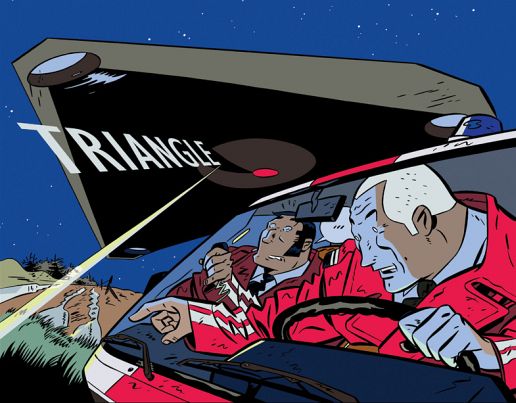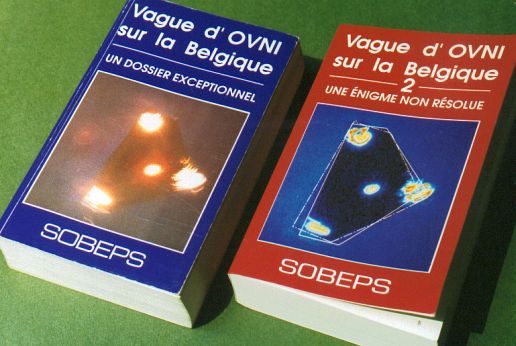For nearly a decade all had been quiet on the European UFO front, until, on October 9, 1989, the Soviet press bureau TASS launched the story of a UFO landing in a park in Voronezh, some 500 km (311 miles) southeast of Moscow. According to a group of school children, a pair of three-eyed giants and a mechanical dwarf had emerged from the landed craft and fired some sort of laser gun at a boy, rendering the child temporarily invisible. The story was repeated in newspapers all over the globe, probably not so much because the editors considered it proof of an alien act of aggression, but because the publication of this bizarre UFO tale in the Soviet Union's leading paper Pravda illustrated the political changes taking place in the former USSR since the beginning of Gorbachev's perestroika.
The story of the Voronezh landing was the first UFO news in a long time to hit the papers in Western Europe. As such it may have helped in creating a suitable environment for the events that were to follow. The first signs that a UFO fever was about to hit Belgium came in the weekend of November 25-26, 1989, when alarmed citizens from the Dutch-speaking part of the country reported seeing a luminous disc circling their homes. Later it turned out that the sightings had been caused by a light-show of a disco in Halen, a small community in the province of Limbourg. The owner of the disco had been trying to attract youngsters by projecting a rotating xenon lamp onto the cloud-deck. Despite the fact that a local UFO group had already identified the culprit, the light-show continued to spark off UFO reports in the area until December 16th, when, after the Belgian Air Force had sent two F-16 fighter planes into the air to identify the lights, the Public Prosecutor's Office ordered the disco manager to switch off his installation.
Four days after the reports had started to trickle in from Limbourg, and some 70 km (43.5 miles) southeast of Halen, in the city of Eupen (we are now in the German-speaking part of the country), another UFO incident occurred. This time the events were to create waves far beyond the borders of the small Belgian state. On November 29, 1989, two officers of the Eupen gendarmerie had the experience of a lifetime. At around 5:20 that evening, as they were driving their patrol car from Eupen to Kettenis, the men spotted a bright light over a field bordering the road. Observing that the light was following a course parallel to theirs, they drove to a point that would take them under the object's predicted trajectory. However, as the unidentified aircraft approached, it stopped, made a full turn and left in the opposite direction. The two men would later describe what they had seen as "a dark solid mass in the shape of an isosceles triangle". Underneath were three blinding white lights, one in each corner. A pulsing red light glowed in the centre. The gendarmes decided to follow the strange craft which was now heading back for Eupen. In the city they paid a quick visit to their headquarters and rang the nearest airfield and a nearby military base. They were told there was no military activity in the region that could account for the sightings.

Through one of the windows of the gendarmerie headquarters the officers could still see a point of light which they presumed to be the unidentified object they had just encountered. It was close to 6:15 p.m. when the two men returned to the patrol car and continued the pursuit. They decided to head for a place called Kortenbach of which they knew it would offer a clear panoramic view of the area. During this trip, the white light seemed to follow each and every movement of the car. When they arrived at Kortenbach, the phenomenon came to a stop. It was now hovering motionless over the watch-tower of the lake of Gileppe, where it stayed for about one hour. In an interview, one of the witnesses stated he had "an unclear impression that, every now and then, there were beams of light shooting out from the sides"[1]. However, in later interviews, the witnesses were quoted as having described "a stationary white ball which repeatedly, but always simultaneously, emitted two clearly visible but very thin beams of a reddish light in opposite directions"[2]. The latter source also speaks of "small fire balls" that were visible at the extremities of the beams and appeared to circle the white ball every time the beams retracted, "much like a yoyo".
While observing this unusual display, a series of bright lights emerged from behind a nearby row of trees. Behind the lights the gendarmes distinguished the dark greenish silhouette of a triangle, probably the same, or a similar object as the one they had witnessed earlier. The object rose into the air and executed a sharp turn. During this manoeuvre an upper structure could be seen with what appeared to be rectangular windows, "similar to a train wagon lit from the inside". The object then followed a spiral trajectory before taking off in the direction of the German border. At exactly 7:23 p.m. the light that was still motionless over the lake, "moved backward" and faded into the distance. [For a sceptic's view on these events, see our article The Gileppe sightings of November 29, 1989]
Throughout the three-hour incident, the officers had been in constant contact with the headquarters in Eupen. Greatly to their relief, the dispatch officer informed them that he too had seen a strange object fly by and that additional sightings were being reported by patrols in nearby communities. One colleague, patrolling the area northwest of Eupen, confirmed that he seen an object carrying three blinding white lights and a pulsing red light, and added that he had also noticed "something at the back of the craft that was turning round, like a turbine". Several more witnesses - some 150 eyewitness accounts were gathered for that night - mentioned a distinct sound that reminded them of a ventilator.
The next day the story of the Eupen "triangle" was highlighted in the press and on various Belgian TV stations. During the first week of December 1989, members of SOBEPS [3], Belgium's largest UFO group, visited the region hoping to find additional witnesses. It marked the beginning of the group's monopoly over the events that were to follow.
As UFO reports kept pouring in for more than two years, the popularity of SOBEPS increased at an equivalent pace. Interviews with members of the group were published in almost every newspaper and magazine in the country. UFOs had become a regular topic in talk-shows on radio and television and almost always the phone number of SOBEPS was mentioned in case someone wanted to report a personal experience. In two years' time, the group collected approximately 2,000 eyewitness accounts, some 450 of which were the subject of some form of investigation. During the years that preceded the UFO wave, SOBEPS had been struggling to keep its head above water. Now, in only a few months time, new volunteers had to be found to go into the field and check as many reports as possible. In 1991 the group published a book in which the best documented cases were detailed. Three years later a second tome saw the light of day.

Sceptics have pointed out that the lack of experience of the new recruits, coupled with the group's preconceived ideas about an extraterrestrial origin of the reported phenomena, inevitably had to result in a largely pseudo-scientific treatment of the events.
Despite the criticism, SOBEPS managed to earn respect from both ufologists and non ufologists, including none other than the Belgian Air Force. During the first weeks of the wave, the B.A.F. had been swamped with telephone calls. With an already chock-full agenda on his hands, Chief of Staff Lieutenant-Colonel Wilfried DE BROUWER, later promoted to Major-General, decided to call in SOBEPS. This marked the beginning of a short but intense relationship which reached its peak during the Easter days of 1990. During a skywatch organized by SOBEPS, a Hawker Siddeley and a Brittan Norman reconnaissance airplane were put at standby. The codename of this historical collaboration was "Opération Identification OVNI". Military men, civilians, investigators, and newsmen took part. The only absentees were the UFOs themselves.
In a 1996 interview with our correspondent Jan VAN EETVELT [4], Major-General DE BROUWER regrets that the Air Force was never given a political mandate nor official instructions or manpower to start an in-depth inquiry into the reports. This meant that the Air staff had to rely on its own creativity to deal with the unusual situation. During the interview, the Major-General emphasized that there has never been a special UFO service operating within the Belgian Army.
Continued on next page >>

